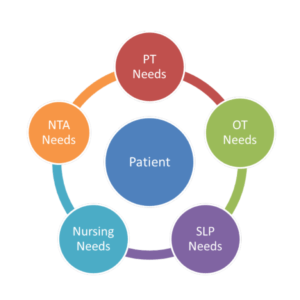POC documentation benefits care, reimbursement
New technologies to document care at the point of care (POC) and to query results and schedules without leaving the resident’s side to use a computer at the nurse’s station, are available now more than ever. Let’s take a look at the benefits of POC technology, what’s available now, what’s coming in the future, and how to select POC systems. Some facilities have seen significant benefits in documentation and increased reimbursement as a result of implementing POC systems.
Benefits
The potential benefits from POC data management are obvious:
Caregivers do not have to write notes to be transcribed later into the chart or computer, saving time and increasing accuracy.
Observations can be analyzed by the computer and reviewed by others immediately after the event allowing more timely intervention.
Caregivers do not have to leave the bedside to access information about the resident. Plans are more likely to be implemented appropriately.
Some technologies facilitate communication among caregivers resulting in more efficient care.
Documentation of care, staff activity, billing, and quality assurance can be more consistent than is possible with manual data entry.
Increased reimbursement by capturing and documenting care more accurately at the time the care is rendered. Activities of daily living documentation and rehabilitation therapy care are especially sensitive to POC support.
Point of care systems may finally reduce the paper demands of clinical care.
Costs
The costs of POC technologies are not as obvious. There is much more to consider than the hardware and software costs, such as:
Devices must be available to all staff expected to use the system. One must also figure in initial hardware cost and cost of breakage and wear and tear.
Infrastructure, such as communications, may need enhancement.
Workflow and procedures will require analysis and changes. This is potentially a major effort.
Staff training is essential.
Staff retraining is essential.
Training new staff is essential.
New technology or regulation may make implemented technology obsolete.
Implementation experiences presented at the 2008 Health Information Technology Summit demonstrated the need for ongoing training and system review to maintain the benefits initially achieved. Without a funded, ongoing support plan, the initial investment will be at risk as staff turnover and new priorities reduce focus on the POC technology.
Ideal POC technology
There is probably no ideal POC technology because different tasks may work best with different technologies, and different staff members may find some technologies more or less difficult to use.
An ideal POC system would have these characteristics, apart from the user interface: small and light, fast, rugged, reliable, easy to use, similar interface to main system, timely database concurrency (data is available for others to see), data is consistent within the system, long life, and inexpensive. There are systems available today that meet all but the last characteristic-and that is relative-if the true system benefits exceed the true total costs of the system then the system could be considered “inexpensive.” Such measurements need to be done over time and periodically reviewed.
POC technology today
A variety of POC technologies is available today. Technical advances in communications and interface design are making new capabilities available all the time.
The table at left summarizes the current hardware environments that can be considered to support POC. While there is no “perfect” POC technology, most major long-term care software vendors have viable options that offer significant benefits now.
Technology | Comments |
Laptop and tablet computers-hand carried or cart mounted. | Can run the same software as the main system, reducing training requirements. May be connected wirelessly to the main system. May run as a workstation for a browser-based system. Small laptops are becoming available. Tablets are still expensive. May be connected to bar code or RFID readers for medication administration functions. Homecare can use wide area network (WAN) technology to access the central database from the client’s home. Infection control may be an issue. Fragile, unless made more rugged. Limited battery life. May be shared by staff members. |
Personal data assistants-Microsoft Windows Mobile, Palm, Tungsten operating systems | May run special application with either continuous or periodic connection to the main system. May run as browser allowing access to the main system. Small and light. Can be brought to the resident even when not in bed. Commercial versions are fragile. Rugged versions are available at higher cost. May be connected to bar code or RFID readers for medication administration functions. Potential for theft. Infection control may be an issue. One per staff member on duty is usual. Homecare can use wide area network (WAN) technology to access the central database from the client’s home. |
Wall-mounted kiosks or computers | Available near the point of care. Flat screens have reduced size dramatically. Touch-sensitive screens facilitate ease of use. May be shared by staff members. |
Radio communication/voice-assisted care | Two-way communication between staff and the system, and with other staff members. Immediate documentation of care. Tracking of system utilization for quality control. No infection control issue since it’s worn by the staff member. One device per staff member is required. |
Smart paper | Not yet seen in long-term care systems, but holds promise. Special pen-like device writes on paper forms and records the data entered electronically. Keeps the paper consistent with the electronic version without keyboard transcription. Almost no learning curve. Requires high-quality color laser printer in addition to the special pen-like devices. |
System selection
As with all technology purchases, POC acquisition requires significant research and review to make informed decisions. Reviewing the literature, sales materials, and case studies are a good start. Developing the business case for POC technology is very facility-specific, depending on the size, budget, staff, location, and philosophy of the institution. Discussions with current users of potential products are highly recommended and a site visit is even better!
The staff who will have to use and implement the technology should be included in the decision-making process. Planning for the life cycle of the product must include ongoing costs, disaster recovery, training new staff members, monitoring use, and harvesting the promised benefits of the technology.
David M. Oatway, RN, MPH, is a long-term care IT consultant based in Key West, Florida. He is Chair of the HIMSS Long Term and Post Acute Care Special Interest Group and a member of the American Health Information Management Association (AHIMA) and Health Level 7 (HL7). A contributor to the development of MDS 2.0, he developed one of the first clinical MDS systems (CHAMP). He is currently supporting CMS’s STRIVE national nursing home time study to help revise the nursing home Medicare PPS.
To send your comments to the editor, e-mail mhrehocik@iadvanceseniorcare.com.
Long-Term Living 2009 June;58(6):54-58
I Advance Senior Care is the industry-leading source for practical, in-depth, business-building, and resident care information for owners, executives, administrators, and directors of nursing at assisted living communities, skilled nursing facilities, post-acute facilities, and continuing care retirement communities. The I Advance Senior Care editorial team and industry experts provide market analysis, strategic direction, policy commentary, clinical best-practices, business management, and technology breakthroughs.
I Advance Senior Care is part of the Institute for the Advancement of Senior Care and published by Plain-English Health Care.
Related Articles
Topics: Articles , Regulatory Compliance











